'Xinjiang Is a Nice Place' opens for a third year
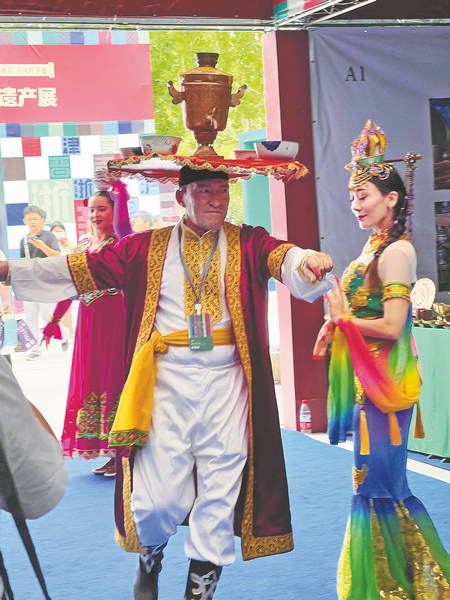
A vivid demonstration of the richness and dynamism of Xinjiang Uygur autonomous region's culture is provided at the 2023 "Xinjiang Is a Nice Place" Intangible Cultural Heritage Exhibition. [Photo/Xu Haoyu]
Gathering of intangible heritage and regional culture has become platform for exchange, Xu Haoyu reports.
On Aug 23, this year's "Xinjiang Is a Nice Place "Intangible Cultural Heritage Exhibition, opened at the Xinjiang Institute of Technology in Aksu prefecture, Xinjiang Uygur autonomous region.
The pristine walls of the exhibition hall were covered in a dazzling array of colorful intangible cultural heritage artworks, and harmonious melodies played as visitors and craftspeople sang and danced together like old friends.
The five-day exhibition was nothing like the silent white cube-like spaces that many modern art exhibitions favor, but was more like a party, featuring inheritors from across the country.
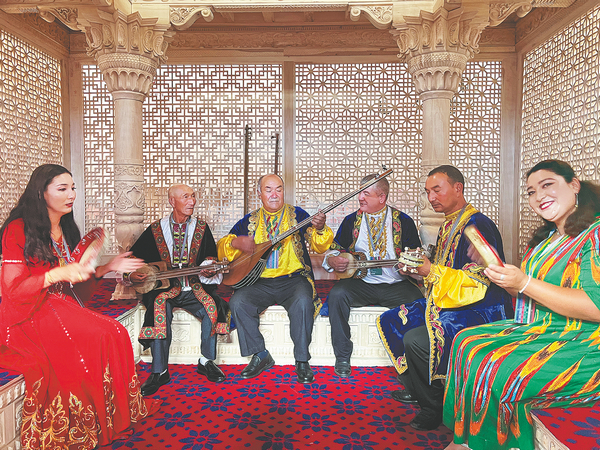
A vivid demonstration of the richness and dynamism of Xinjiang Uygur autonomous region's culture is provided at the 2023 "Xinjiang Is a Nice Place" Intangible Cultural Heritage Exhibition. [Photo/Xu Haoyu]
In the Turpan city exhibition area, a man, Torshun, gave a performance of nazikum, a type of dance.
Dressed in intricately patterned attire and wearing a small floral cap, he danced to lively and upbeat music.
His exaggerated dance moves included bending his knees and leaning his body forward while swinging his arms vigorously and sometimes, he squatted down, extending his arms and bending his wrists to imitate a duck, making the audience laugh.
Nazikum is a nationally recognized form of intangible cultural heritage, and is usually performed during the agricultural off-season or at weddings, creating a lively and joyful atmosphere.
As the performance continued, a woman dressed in a red costume jumped into the booth and spontaneously began dancing the yangko.
Torshun stepped closer to her, squeezing his face to make funny facial expressions.
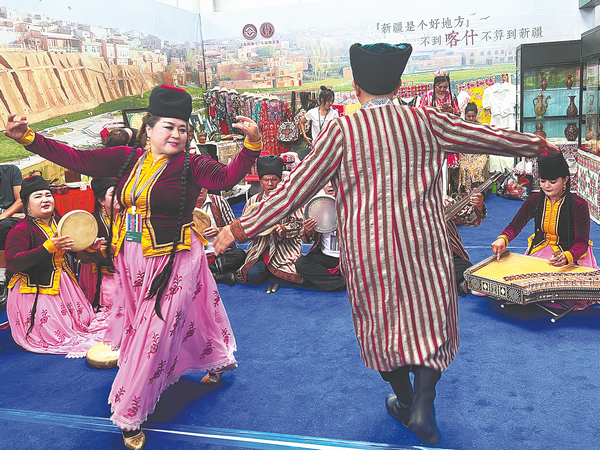
A vivid demonstration of the richness and dynamism of Xinjiang Uygur autonomous region's culture is provided at the 2023 "Xinjiang Is a Nice Place" Intangible Cultural Heritage Exhibition. [Photo/Xu Haoyu]
As the song finished, the woman rushed back to her own booth.
It turned out she was a performer from the Changji Hui autonomous prefecture, and was there representing the nationally recognized intangible cultural heritage of Xinjiang shehuo. Her vibrant outfit was traditional Hui attire.
"I don't know how to dance their style (nazikum)," she says, "our cultures are different, but music is universal. We always start dancing when we hear music."
According to Zhong Weishan, the team leader of the performance group from the Changji exhibition area, Xinjiang shehuo is a collective term for various kinds of folk celebrations. It includes the yangko dance, dragon and lion dances, and drum performances, and often incorporates folk tales like Journey to the West.
As the sound of drums was heard, dancers began waving green fans and spinning blue-and-yellow umbrellas embellished with pink decorations. They smiled brightly while performing the yangko, triggering resounding applause.
In addition to their captivating song and dance performances, the Changji exhibition booth also featured aromatic delicacies and decorative steamed buns known as "flower buns", that filled the air with an inviting scent.
Gan Huiqiong, an inheritor of flower bun-making, is good at shaping dough into all kinds of animals and human figures.
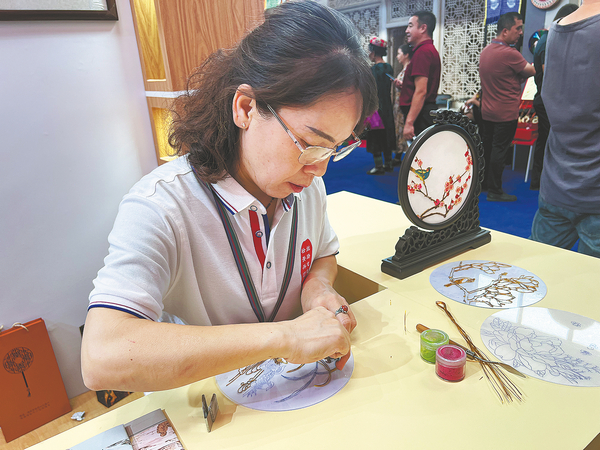
Wang Lanfang, from Shihezi, Xinjiang, shows cloisonne enamel, an ancient technique for decorating metallic objects. [Photo/Xu Haoyu]
"The process of making flower buns is time-consuming, and follows a strict sequence: mixing the dough, fermenting, kneading, shaping, and finally steaming," Gan says.
"Each step must be executed with precision, any carelessness can ruin the whole thing.
"Sometimes I get so busy that I work for over 12 hours straight, but I don't feel tired at all," Gan adds, smiling proudly.
The Jiangxi province exhibition booth, which featured porcelain from Jingdezhen, was crowded. Visitors were amazed by the exquisite craftsmanship, repeatedly examining tea bowls and cups, and capturing the intricate details with their smartphones.
"This exhibition has broadened my horizons, as inheritors of intangible cultural heritage across the country have gathered here," says Chen Fanguo, a representative inheritor of Jingdezhen porcelain, a form of nationally recognized intangible cultural heritage from Jiangxi.
"We can learn from each other and inspire each other, enhancing our ability to preserve our respective crafts. I also welcome friends from Xinjiang to Jingdezhen to experience its thousand-year ceramic culture."
Chen's porcelain attracted a lot of attention and buyers. By the third day of the exhibition, only a few of his signature tea sets remained on display.
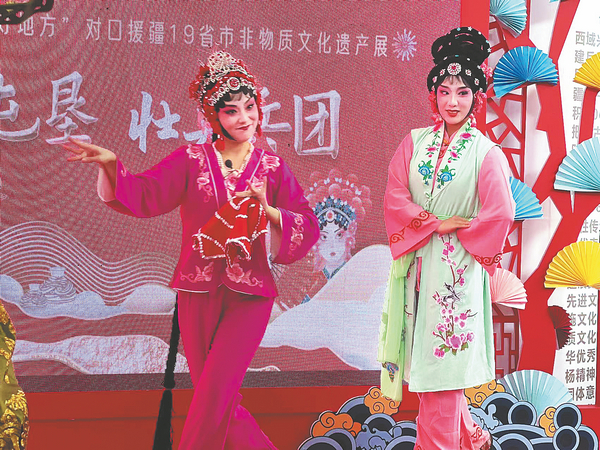
A Chinese opera performance by Xinjiang Production and Construction Corps. [Photo/Xu Haoyu]
"Blue-and-white porcelain is closely related to tea culture. In recent years, as the popularity of tea culture has risen, so has the demand for quality tea sets," Chen says.
"Jingdezhen, which is known as the 'porcelain capital of China,' naturally attracts attention. As long as we carefully control the quality of each piece, we will gain greater recognition," he adds.
Co-hosted by the Ministry of Culture and Tourism and the People's Government of the Xinjiang Uygur autonomous region, the exhibition has been held for three consecutive years. This year, it was held outside of Urumqi city for the first time.
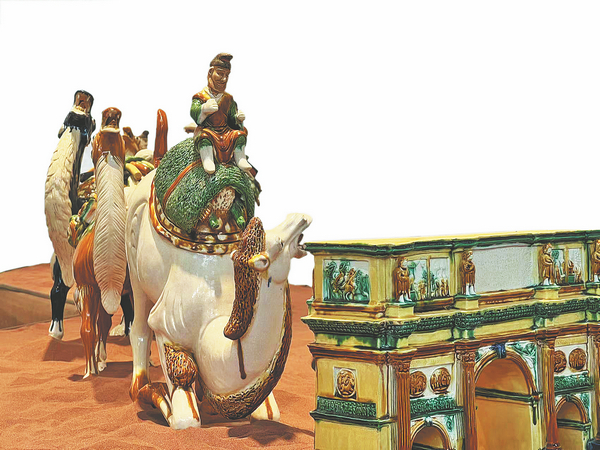
Tricolor-glazed sancai ceramics from the Tang Dynasty (618-907). [Photo/Xu Haoyu]
In his speech, Rao Quan, deputy minister of Ministry of Culture and Tourism, said that the national culture and tourism system has embraced the spirit of the 20th National Congress of the Communist Party of China and the third central symposium on work related to Xinjiang.
He said that after three consecutive years, the exhibition of intangible cultural heritage has become a distinctive activity for enriching culture in Xinjiang, serving as a platform for cultural exchange and interaction, as well as an important showcase for achievements in the preservation of intangible cultural heritage and the cultural development of Xinjiang.
"Drawing upon the unique characteristics of culture and tourism, and making good use of the abundant related resources, we aim to carry out the 'Culture Enriches Xinjiang' initiative in a better way, and contribute to building a shared spiritual home for the country," he says.